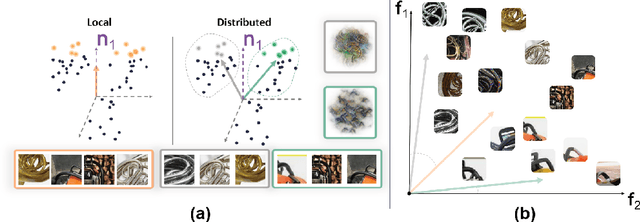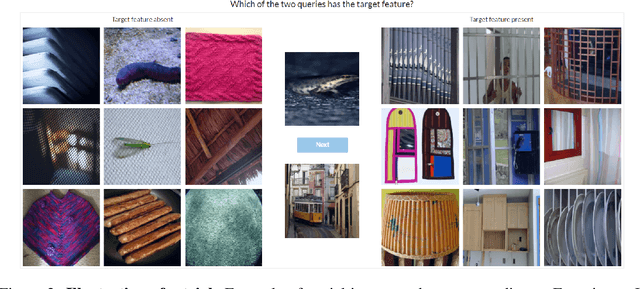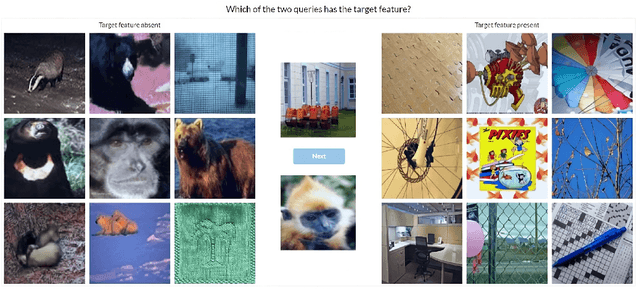Thomas Fel
IRIT
Uncovering Conceptual Blindspots in Generative Image Models Using Sparse Autoencoders
Jun 24, 2025Abstract:Despite their impressive performance, generative image models trained on large-scale datasets frequently fail to produce images with seemingly simple concepts -- e.g., human hands or objects appearing in groups of four -- that are reasonably expected to appear in the training data. These failure modes have largely been documented anecdotally, leaving open the question of whether they reflect idiosyncratic anomalies or more structural limitations of these models. To address this, we introduce a systematic approach for identifying and characterizing "conceptual blindspots" -- concepts present in the training data but absent or misrepresented in a model's generations. Our method leverages sparse autoencoders (SAEs) to extract interpretable concept embeddings, enabling a quantitative comparison of concept prevalence between real and generated images. We train an archetypal SAE (RA-SAE) on DINOv2 features with 32,000 concepts -- the largest such SAE to date -- enabling fine-grained analysis of conceptual disparities. Applied to four popular generative models (Stable Diffusion 1.5/2.1, PixArt, and Kandinsky), our approach reveals specific suppressed blindspots (e.g., bird feeders, DVD discs, and whitespaces on documents) and exaggerated blindspots (e.g., wood background texture and palm trees). At the individual datapoint level, we further isolate memorization artifacts -- instances where models reproduce highly specific visual templates seen during training. Overall, we propose a theoretically grounded framework for systematically identifying conceptual blindspots in generative models by assessing their conceptual fidelity with respect to the underlying data-generating process.
Evaluating Sparse Autoencoders: From Shallow Design to Matching Pursuit
Jun 05, 2025Abstract:Sparse autoencoders (SAEs) have recently become central tools for interpretability, leveraging dictionary learning principles to extract sparse, interpretable features from neural representations whose underlying structure is typically unknown. This paper evaluates SAEs in a controlled setting using MNIST, which reveals that current shallow architectures implicitly rely on a quasi-orthogonality assumption that limits the ability to extract correlated features. To move beyond this, we introduce a multi-iteration SAE by unrolling Matching Pursuit (MP-SAE), enabling the residual-guided extraction of correlated features that arise in hierarchical settings such as handwritten digit generation while guaranteeing monotonic improvement of the reconstruction as more atoms are selected.
Interpreting the Linear Structure of Vision-language Model Embedding Spaces
Apr 16, 2025



Abstract:Vision-language models encode images and text in a joint space, minimizing the distance between corresponding image and text pairs. How are language and images organized in this joint space, and how do the models encode meaning and modality? To investigate this, we train and release sparse autoencoders (SAEs) on the embedding spaces of four vision-language models (CLIP, SigLIP, SigLIP2, and AIMv2). SAEs approximate model embeddings as sparse linear combinations of learned directions, or "concepts". We find that, compared to other methods of linear feature learning, SAEs are better at reconstructing the real embeddings, while also able to retain the most sparsity. Retraining SAEs with different seeds or different data diet leads to two findings: the rare, specific concepts captured by the SAEs are liable to change drastically, but we also show that the key commonly-activating concepts extracted by SAEs are remarkably stable across runs. Interestingly, while most concepts are strongly unimodal in activation, we find they are not merely encoding modality per se. Many lie close to - but not entirely within - the subspace defining modality, suggesting that they encode cross-modal semantics despite their unimodal usage. To quantify this bridging behavior, we introduce the Bridge Score, a metric that identifies concept pairs which are both co-activated across aligned image-text inputs and geometrically aligned in the shared space. This reveals that even unimodal concepts can collaborate to support cross-modal integration. We release interactive demos of the SAEs for all models, allowing researchers to explore the organization of the concept spaces. Overall, our findings uncover a sparse linear structure within VLM embedding spaces that is shaped by modality, yet stitched together through latent bridges-offering new insight into how multimodal meaning is constructed.
Projecting Assumptions: The Duality Between Sparse Autoencoders and Concept Geometry
Mar 03, 2025Abstract:Sparse Autoencoders (SAEs) are widely used to interpret neural networks by identifying meaningful concepts from their representations. However, do SAEs truly uncover all concepts a model relies on, or are they inherently biased toward certain kinds of concepts? We introduce a unified framework that recasts SAEs as solutions to a bilevel optimization problem, revealing a fundamental challenge: each SAE imposes structural assumptions about how concepts are encoded in model representations, which in turn shapes what it can and cannot detect. This means different SAEs are not interchangeable -- switching architectures can expose entirely new concepts or obscure existing ones. To systematically probe this effect, we evaluate SAEs across a spectrum of settings: from controlled toy models that isolate key variables, to semi-synthetic experiments on real model activations and finally to large-scale, naturalistic datasets. Across this progression, we examine two fundamental properties that real-world concepts often exhibit: heterogeneity in intrinsic dimensionality (some concepts are inherently low-dimensional, others are not) and nonlinear separability. We show that SAEs fail to recover concepts when these properties are ignored, and we design a new SAE that explicitly incorporates both, enabling the discovery of previously hidden concepts and reinforcing our theoretical insights. Our findings challenge the idea of a universal SAE and underscores the need for architecture-specific choices in model interpretability. Overall, we argue an SAE does not just reveal concepts -- it determines what can be seen at all.
Archetypal SAE: Adaptive and Stable Dictionary Learning for Concept Extraction in Large Vision Models
Feb 18, 2025Abstract:Sparse Autoencoders (SAEs) have emerged as a powerful framework for machine learning interpretability, enabling the unsupervised decomposition of model representations into a dictionary of abstract, human-interpretable concepts. However, we reveal a fundamental limitation: existing SAEs exhibit severe instability, as identical models trained on similar datasets can produce sharply different dictionaries, undermining their reliability as an interpretability tool. To address this issue, we draw inspiration from the Archetypal Analysis framework introduced by Cutler & Breiman (1994) and present Archetypal SAEs (A-SAE), wherein dictionary atoms are constrained to the convex hull of data. This geometric anchoring significantly enhances the stability of inferred dictionaries, and their mildly relaxed variants RA-SAEs further match state-of-the-art reconstruction abilities. To rigorously assess dictionary quality learned by SAEs, we introduce two new benchmarks that test (i) plausibility, if dictionaries recover "true" classification directions and (ii) identifiability, if dictionaries disentangle synthetic concept mixtures. Across all evaluations, RA-SAEs consistently yield more structured representations while uncovering novel, semantically meaningful concepts in large-scale vision models.
Universal Sparse Autoencoders: Interpretable Cross-Model Concept Alignment
Feb 06, 2025Abstract:We present Universal Sparse Autoencoders (USAEs), a framework for uncovering and aligning interpretable concepts spanning multiple pretrained deep neural networks. Unlike existing concept-based interpretability methods, which focus on a single model, USAEs jointly learn a universal concept space that can reconstruct and interpret the internal activations of multiple models at once. Our core insight is to train a single, overcomplete sparse autoencoder (SAE) that ingests activations from any model and decodes them to approximate the activations of any other model under consideration. By optimizing a shared objective, the learned dictionary captures common factors of variation-concepts-across different tasks, architectures, and datasets. We show that USAEs discover semantically coherent and important universal concepts across vision models; ranging from low-level features (e.g., colors and textures) to higher-level structures (e.g., parts and objects). Overall, USAEs provide a powerful new method for interpretable cross-model analysis and offers novel applications, such as coordinated activation maximization, that open avenues for deeper insights in multi-model AI systems
Sparks of Explainability: Recent Advancements in Explaining Large Vision Models
Feb 03, 2025Abstract:This thesis explores advanced approaches to improve explainability in computer vision by analyzing and modeling the features exploited by deep neural networks. Initially, it evaluates attribution methods, notably saliency maps, by introducing a metric based on algorithmic stability and an approach utilizing Sobol indices, which, through quasi-Monte Carlo sequences, allows a significant reduction in computation time. In addition, the EVA method offers a first formulation of attribution with formal guarantees via verified perturbation analysis. Experimental results indicate that in complex scenarios these methods do not provide sufficient understanding, particularly because they identify only "where" the model focuses without clarifying "what" it perceives. Two hypotheses are therefore examined: aligning models with human reasoning -- through the introduction of a training routine that integrates the imitation of human explanations and optimization within the space of 1-Lipschitz functions -- and adopting a conceptual explainability approach. The CRAFT method is proposed to automate the extraction of the concepts used by the model and to assess their importance, complemented by MACO, which enables their visualization. These works converge towards a unified framework, illustrated by an interactive demonstration applied to the 1000 ImageNet classes in a ResNet model.
An Adaptive Orthogonal Convolution Scheme for Efficient and Flexible CNN Architectures
Jan 14, 2025



Abstract:Orthogonal convolutional layers are the workhorse of multiple areas in machine learning, such as adversarial robustness, normalizing flows, GANs, and Lipschitzconstrained models. Their ability to preserve norms and ensure stable gradient propagation makes them valuable for a large range of problems. Despite their promise, the deployment of orthogonal convolution in large-scale applications is a significant challenge due to computational overhead and limited support for modern features like strides, dilations, group convolutions, and transposed convolutions.In this paper, we introduce AOC (Adaptative Orthogonal Convolution), a scalable method for constructing orthogonal convolutions, effectively overcoming these limitations. This advancement unlocks the construction of architectures that were previously considered impractical. We demonstrate through our experiments that our method produces expressive models that become increasingly efficient as they scale. To foster further advancement, we provide an open-source library implementing this method, available at https://github.com/thib-s/orthogonium.
Local vs distributed representations: What is the right basis for interpretability?
Nov 06, 2024



Abstract:Much of the research on the interpretability of deep neural networks has focused on studying the visual features that maximally activate individual neurons. However, recent work has cast doubts on the usefulness of such local representations for understanding the behavior of deep neural networks because individual neurons tend to respond to multiple unrelated visual patterns, a phenomenon referred to as "superposition". A promising alternative to disentangle these complex patterns is learning sparsely distributed vector representations from entire network layers, as the resulting basis vectors seemingly encode single identifiable visual patterns consistently. Thus, one would expect the resulting code to align better with human perceivable visual patterns, but supporting evidence remains, at best, anecdotal. To fill this gap, we conducted three large-scale psychophysics experiments collected from a pool of 560 participants. Our findings provide (i) strong evidence that features obtained from sparse distributed representations are easier to interpret by human observers and (ii) that this effect is more pronounced in the deepest layers of a neural network. Complementary analyses also reveal that (iii) features derived from sparse distributed representations contribute more to the model's decision. Overall, our results highlight that distributed representations constitute a superior basis for interpretability, underscoring a need for the field to move beyond the interpretation of local neural codes in favor of sparsely distributed ones.
Unearthing Skill-Level Insights for Understanding Trade-Offs of Foundation Models
Oct 17, 2024



Abstract:With models getting stronger, evaluations have grown more complex, testing multiple skills in one benchmark and even in the same instance at once. However, skill-wise performance is obscured when inspecting aggregate accuracy, under-utilizing the rich signal modern benchmarks contain. We propose an automatic approach to recover the underlying skills relevant for any evaluation instance, by way of inspecting model-generated rationales. After validating the relevance of rationale-parsed skills and inferring skills for $46$k instances over $12$ benchmarks, we observe many skills to be common across benchmarks, resulting in the curation of hundreds of skill-slices (i.e. sets of instances testing a common skill). Inspecting accuracy over these slices yields novel insights on model trade-offs: e.g., compared to GPT-4o and Claude 3.5 Sonnet, on average, Gemini 1.5 Pro is $18\%$ more accurate in "computing molar mass", but $19\%$ less accurate in "applying constitutional law", despite the overall accuracies of the three models differing by a mere $0.4\%$. Furthermore, we demonstrate the practical utility of our approach by showing that insights derived from skill slice analysis can generalize to held-out instances: when routing each instance to the model strongest on the relevant skills, we see a $3\%$ accuracy improvement over our $12$ dataset corpus. Our skill-slices and framework open a new avenue in model evaluation, leveraging skill-specific analyses to unlock a more granular and actionable understanding of model capabilities.
 Add to Chrome
Add to Chrome Add to Firefox
Add to Firefox Add to Edge
Add to Edge